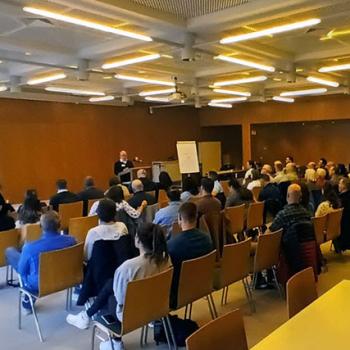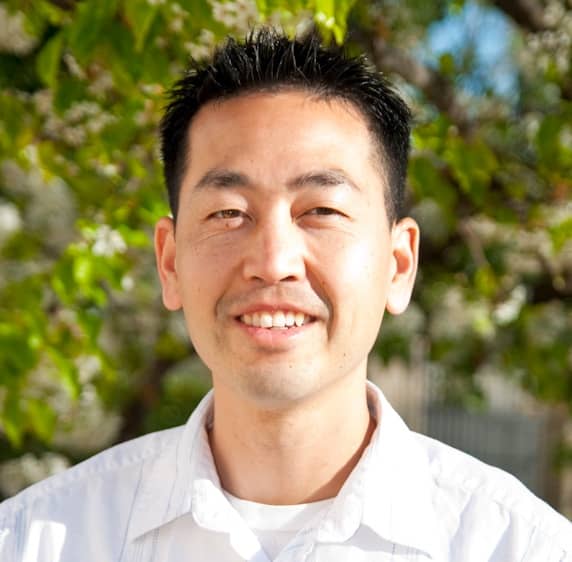
Although Jesus lived in a sin-struck world, he was able as the Son of God to heal the sick and also raise the dead.
Jesus Raised the Dead (John 11:38–45)
During his earthly ministry, Jesus said “No” to death by showing his power over death. He raised to life a boy in the town of Nain: “Young man, I say to you, arise” (Luke 7:11–17). And he resurrected the daughter of Jairus: “All were weeping and mourning for her, but [Jesus] said, ‘Do not weep, for she is not dead but sleeping’” (8:52). “They laughed at him, knowing that she was dead. But taking her by the hand he called, saying, ‘Child, arise.’ And her spirit returned, and she got up at once. And he directed that something should be given her to eat. And her parents were amazed, but he charged them to tell no one what had happened” (vv. 53–56). Likewise, Jesus would raise his friend, Lazarus, from the dead.
Then Jesus, deeply moved again, came to the tomb. It was a cave, and a stone lay against it. Jesus said, “Take away the stone.” Martha, the sister of the dead man, said to him, “Lord, by this time there will be an odor, for he has been dead four days.” Jesus said to her, “Did I not tell you that if you believed you would see the glory of God?” So they took away the stone. And Jesus lifted up his eyes and said, “Father, I thank you that you have heard me. I knew that you always hear me, but I said this on account of the people standing around, that they may believe that you sent me.” When he had said these things, he cried out with a loud voice, “Lazarus, come out.” The man who had died came out, his hands and feet bound with linen strips, and his face wrapped with a cloth. Jesus said to them, “Unbind him, and let him go.” Many of the Jews therefore, who had come with Mary and had seen what he did, believed in him (John 11:38–45).
How do we explain this phenomenon that Jesus had the power to raise the dead? As Jesus himself explained to Martha: “I am the resurrection and the life. Whoever believes in me, though he die, yet shall he live, and everyone who lives and believes in me shall never die. Do you believe this?” (vv. 25–26). Yet was Jesus talking about the present day or the last day? Lazarus would experience both. For on that day, Jesus raised Lazarus from the dead. Yet on the final day, he will raise all his friends from the dead (including Lazarus, who unfortunately had to die a second time). The first resurrection of Lazarus was simply a foretaste of eternal glory to prove to everyone that Jesus could really do it—a test model to show his capabilities. Jesus taught, however, “Do not marvel at this, for an hour is coming when all who are in the tombs will hear his voice and come out, those who have done good to the resurrection of life, and those who have done evil to the resurrection of judgment” (5:28–29).
Application Insight: One day, what happened to Lazarus and the daughter of Jairus and the young man in the town of Nain, will happen to every single person. You can know this promise of the resurrection to be true because Jesus himself rose from the dead.
Jesus Rose from the Dead Himself (1 Corinthians 15:3–4)
Jesus said “No” to sickness and death by healing the sick and raising the dead. Finally, he said “No” by rising from the dead himself. Jesus prophesied multiple times, throughout his ministry, that he would die: “For even the Son of Man came not to be served but to serve, and to give his life as a ransom for many” (Mark 10:45). In the same breath, however, he would often foretell his resurrection (vv. 32–34). For example, he taught his disciples “that the Son of Man must suffer many things and be rejected by the elders and the chief priests and the scribes and be killed, and after three days rise again” (8:31). Then, when the time came, Jesus went willingly to the cross (Matthew 26:1–27:66). He died for sinners and was buried in the ground for three days. As Paul wrote, “For I delivered to you as of first importance what I also received: that Christ died for our sins in accordance with the Scriptures, that he was buried, that he was raised on the third day in accordance with the Scriptures” (1 Corinthians 15:3–4). Three days after his crucifixion, just as he promised, Jesus rose from the dead himself (Matthew 28:1–20).
Our world looks at sickness and death primarily through a material lens. If you’re sick, you see a doctor, take a prescription, or switch to an organic diet. Sickness and death can be held off by good exercise and a healthy lifestyle. Yet Christians are compelled to look at all of life through a theological lens: God created us as embodied souls. We have physical bodies that affect our spiritual life and spiritual souls that affect what happens to our body. Body and soul are interconnected.
Application Insight: The church must minister to both body and soul. So, take care of your physical body: Get adequate sleep, consult with your doctor, profit from exercise, and don’t pig out. Learn how the Lord ministered to Elijah physically before he ministered to him spiritually (1 Kings 19:5–18). Yet also take care of your spiritual soul: Surround yourself with loving support (vv. 19–21). Don’t run from the church or be ashamed to ask for help. Find good friends who will gently confront you if sickness changes your attitude or your behavior toward others (Prov 27:6). Observe how the Lord ministered to David spiritually before he ministered to him physically (Psalms 32; 51).
In 1 Peter 2:24, “[Jesus] himself bore our sins in his body on the tree, that we might die to sin and live to righteousness. By his wounds you have been healed.” Peter quoted from Isaiah 53 to show that Jesus is our healer. Yet whereas Matthew 8 spoke of physical healing, Peter spoke of spiritual healing through the forgiveness of sin. Isaiah prophesied a suffering Savior who would take away sin and all sin’s consequences. Matthew presented a victorious Savior who healed the sick and cast out demons and raised the dead as a foretaste of heaven. Then, Peter described an atoning Savior who bore our sins and gave to us his perfect righteousness. By conquering spiritual suffering, Jesus also conquered physical suffering. The two were interconnected.
Here is the gospel! A holy God created our world without sickness—without death. Yet Adam’s sin corrupted God’s perfect world. Therefore, sickness is a cursed consequence of Adam’s sin and death is the penalty for all who rebel against a holy God (Romans 6:23a). So, when sickness or death assaults our life or a loved one’s life, it is appropriate to grieve. They remind us that we still live in a fallen world which has fallen short of heavenly glory (3:23). Yet the gospel promises a greater hope than anything this world affords (1 Thessalonians 4:13–18).
Application Insight: Rejoice in the good news that Jesus Christ became a man who suffered and got sick like you. He died like every person will one day die. And because he died, “he himself bore our sins in his body on the tree, that we might die to sin and live to righteousness.” Because he died, “By his wounds you have been healed.” Even if, God forbid, you contract the most horrible disease known to man or die the most excruciating death imaginable, at least your sins are forgiven if you believe in Christ.
You can endure the most painful earthly suffering and still cling with hope to eternal glory. For you will not enter heaven by maintaining your good health, but likely through death’s door. As Peter encourages suffering believers,
Blessed be the God and Father of our Lord Jesus Christ! According to his great mercy, he has caused us to be born again to a living hope through the resurrection of Jesus Christ from the dead, to an inheritance that is imperishable, undefiled, and unfading, kept in heaven for you, who by God's power are being guarded through faith for a salvation ready to be revealed in the last time. In this you rejoice, though now for a little while, if necessary, you have been grieved by various trials, so that the tested genuineness of your faith—more precious than gold that perishes though it is tested by fire—may be found to result in praise and glory and honor at the revelation of Jesus Christ (1 Peter 1:3–7).
You may never know God’s reasons for certain trials or why he chooses to heal some and not others (e.g., Job 1–2). Yet you have hope in the resurrection of Jesus Christ, for heaven promises the Christian a future life—an eternal life—a life without sickness—a life without end.
Application Insight: If you do not enjoy a relationship with Jesus Christ, your greatest suffering will not be physical, but rather the spiritual suffering which awaits you in eternity: “It is appointed for man to die once, and after that comes judgment” (Hebrews 9:27). Therefore, believe in Jesus as your Lord and Savior and escape that spiritual death (Romans 10:9).
Even more wonderfully, you need not wait for heaven to access the healing power of Jesus today! For Christ removes the present curse of sin and offers a foretaste of heaven’s glory! As with Lazarus, he may not heal you instantly, though you ask in prayer (James 5:14–15). But when you pray, you commune with God who knows you intimately as his child.
Application Insight: The sovereign God has planned out your entire life, thus your sickness is never beyond his control. The compassionate God weeps for you not because he is powerless, but because he cares. And the powerful God acts on your behalf. His death takes away your sin and makes your healing possible. His death heals you spiritually and grants you entrance into heaven’s eternal glories. For Jesus has said “No” to sickness and to death both in this life and in the life to come.
4/28/2023 9:56:10 PM





